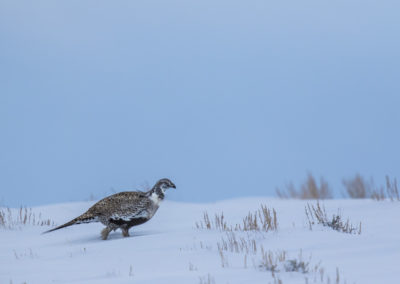Wintertime in the High Desert is harsh for most wildlife. Animals such as pronghorn antelope or mule deer spend a lot of energy constantly looking for food; harsh weather, with few choices for shelter, makes winter months even more difficult. Most animals hit their lowest body fitness during the winter.
Sage-grouse, however, are one of the few animals that thrive during winter in the High Desert. Throughout the year, sagebrush leaves provide nutrition and shelter to the birds. During harsh winter months, sagebrush leaves are the key to their survival, providing the bird’s only food source. Snow provides a reliable water source for the birds.
In a sense, snow frees the birds. In the summer, they congregate near scarce water sources, which also attract a host of predators. But as winter approaches, sage-grouse begin to move to higher elevations where snow will furnish the water they need. They congregate there in large groups until spring.
Sage-grouse are equipped with long toes to help them dig through snow to reach the protein-packed sage leaves. Fine hairs develop along their feet, functioning like snowshoes and allowing them to walk and dig in deep snow.
This January, I went to Wyoming hoping to document sage-grouse’s winter behaviors. The snow was deeper than last year when I was there. Wind swept the open, high desert, where I saw a large number of birds feeding on snow-covered sagebrush and a couple of hundred more birds flying in the distance. They looked well-fed, thanks to nutrient-rich sagebrush leaves. With good habitat and food, sage-grouse can not only survive in winter, but thrive in it. Where good sagebrush habitat is protected, sage-grouse populations have the opportunity to grow.




We must protect their environment if they are to flourish. Your pictures of this magnificent bird are incredible. Thanks for enlightening us.